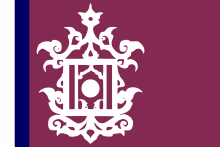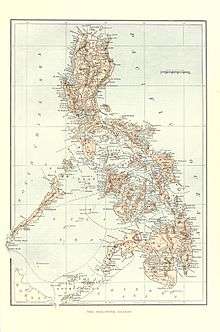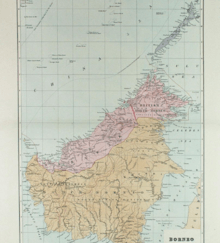Lupah Sug
Lupah Sug
| |||||||||||
|---|---|---|---|---|---|---|---|---|---|---|---|
| c. 12th century–1405 | |||||||||||
| Capital | Seat of power is based at Maimbung Jolo, Sulu Strait. | ||||||||||
| Common languages | , Tausug, Arabic, Bajau, Visayan, Banguingui and Old Malay | ||||||||||
| Religion | Indigenous religion, syncretistically adapting elements from Hinduism and Buddhism. (see also Polytheism) | ||||||||||
| Government | Barangay State | ||||||||||
| Rajahnate | |||||||||||
• before 1280 CE. | Rajah Sipad the Older (first) | ||||||||||
• 1405 | Sultan Sharif ul-Hashim | ||||||||||
| History | |||||||||||
• The Principality of Maimbung, populated by Buranun people , was first ruled by Rajah Sipad the Older. | c. 12th century | ||||||||||
• Establishment of Sultanate of Sulu | 1405 | ||||||||||
| Currency | Barter | ||||||||||
| |||||||||||
| Today part of |
| ||||||||||
Part of a series on the |
||||||||||||||||||||||||||
|---|---|---|---|---|---|---|---|---|---|---|---|---|---|---|---|---|---|---|---|---|---|---|---|---|---|---|
| History of Brunei | ||||||||||||||||||||||||||
| Pre-Sultanate | ||||||||||||||||||||||||||
|
||||||||||||||||||||||||||
|
||||||||||||||||||||||||||
| ||||||||||||||||||||||||||
In the Philippine history, the Lupah Sug (Jawi: سوگ Sūg) was a predecessor state before the establishment of Sultanate of Sulu.[1]
Background
Sulu that time was called Lupah Sug[1] The Principality of Maimbung, populated by Buranun people (or Budanon, literally means "mountain-dwellers"), was first ruled by a certain rajah who assumed the title Rajah Sipad the Older. According to Majul, the origins of the title rajah sipad originated from the Hindu sri pada, which symbolises authority.[2] The Principality was instituted and governed using the system of rajahs. Sipad the Older was succeeded by Sipad the Younger.
Customs of people up to the arival of Tuan Mashā′ikha
During the reign of Sipad the Younger, a mystic[3] named Tuan Mashā′ikha[note 1] arrived in Jolo in 1280 AD.[note 2] Little is known to the origins and early biography of Tuan Mashā′ikha, except that he is a Muslim "who came from foreign lands" at the head of a fleet of Muslim traders,[5] or he was issued from a stalk of bamboo and was considered a prophet, thus well respected by the people.[6] Other reports, however, insisted that Tuan Mashā′ikha together with his parents, Jamiyun Kulisa and Indra Suga, were sent to Sulu by Alexander the Great (who is known as Iskandar Zulkarnain in Malay Annals).[2] However, Saleeby dismisses this claim by concluding that Jamiyun Kulisa and Indra Suga were mythical names.[6] According to tarsila, during the coming of Tuan Mashā′ikha, the people of Maimbung worshipped tombs and stones of any kind. After he preached Islam in the area, he married Sipad the Younger's daughter, Idda Indira Suga and bore three children:[7] Tuan Hakim, Tuan Pam and 'Aisha. Tuan Hakim, in turn, begot five children.[8] From the genealogy of Tuan Mashā′ikha, another titular system of aristocracy called "tuanship" started in Sulu. Apart from the Idda Indira Suga, Tuan Mashā′ikha also married into another "unidentified woman" and begot Moumin. Tuan Mashā′ikha died in 710 A.H. (equivalent to 1310 AD), and was buried in Bud Dato near Jolo, with an inscription of Tuan Maqbālū.[9]
Islamisation and establishment of the Sultanate
The sultanate was founded on 17 November 1405.[10][note 3] by a Johore-born explorer and religious scholar Sharif ul-Hashim. Paduka Mahasari Maulana al Sultan Sharif ul-Hashim became his full regnal name, Sharif-ul Hashim is his abbreviated name. He settled in Buansa, Sulu. After the marriage of Abu Bakr and a local dayang-dayang (princess) Paramisuli, he founded the sultanate. The Sultanate gained its independence from the Bruneian Empire in 1578.[14]
At the end of the 14th century, a notable Arab judge and religious scholar named Karim ul-Makhdum[note 4] from Mecca arrived in the Malacca Sultanate. He preached Islam to the people, and thus many citizens, including the ruler of Malacca, converted to Islam.[15] Chinese Muslims, Arabs, Persians, Malays, and Indian Muslims introduced Sulu and other Muslim sultanates to Islam. Chinese Muslim merchants participated in the local commerce, and the Sultanate had diplomatic relations with China during the time of the Ming Dynasty (1368–1644), being involved in the tribute system. The Sulu leader Paduka Pahala and his sons moved to China, where he died, and Chinese Muslims brought up his sons in Dezhou, where their descendants live and have the surnames An and Wen.[16]
In 1380 AD,[note 5] Karim ul-Makhdum arrived in Simunul island from Malacca, again with Arab traders. Apart from being a scholar, he operated as a trader, some see him as a Sufi missionary originating from Mecca.[17] He preached Islam in the area, and was thus accepted by the core Muslim community. He was the second person who preached Islam in the area, following Tuan Mashā′ikha. To facilitate easy conversion of nonbelievers, he established a mosque in Tubig-Indagan, Simunul, which became the first Islamic temple to be constructed in the area, as well as the first in the Philippines. This later became known as Sheik Karimal Makdum Mosque.[18] He died in Sulu, though the exact location of his grave is unknown. In Buansa, he was known as Tuan Sharif Awliyā.[2] On his alleged grave in Bud Agad, Jolo, an inscription was written as "Mohadum Aminullah Al-Nikad". In Lugus, he is referred to Abdurrahman. In Sibutu, he is known to as his name.[19]
The different of beliefs on his grave locations came about due to the fact that Karim ul-Makhdum travelled to several islands in Sulu Sea to preach Islam. In many places in the archipelago, he was beloved. It is said that the people of Tapul built a mosque honouring him and that they claim descent from Karim ul-Makhdum. Thus, the success of Karim ul-Makhdum of spreading Islam in Sulu threw a new light in Islamic history in the Philippines. The customs, beliefs and political laws of the people changed and customised to adopt the Islamic tradition.[20]
Recorded monarchs
| title | Ruler | events | From | Until |
|---|---|---|---|---|
| Rajah | Sipad the Older | His name derived from Sanskrit Sri Pada. | c.1280 | |
| Rajah | Sipad the Younger | 1280 | 1405 | |
| Sultan | Sharif ul-Hashim | The founder of the Sulu sultanate, whose proper name was Sayyid walShareef Abu Bakr ibn Abirin AlHashmi. He founded The Royal Sultanate of Sulu in 1457 and renamed himself Paduka Mahasari Maulana al-Sultan Sharif ul-Hashim, which roughly translates from Arabic as "The Master His Majesty, Protector and Sultan, Noble of the Banu Hashim Clan".[citation needed] The Sultan is reported to have lived about thirty years in Buansa, the first seat of the sultanate, and his tomb is located in one of the slopes of nearby Mount Tumantangis | 1405 |
See also
Notes
- ↑ Mashā′ikha is an Arabic term which originated from mashā′ikh, which means "an intelligent or pious man".
- ↑ The generally accepted date for the coming of Tuan Mashā′ikha is 1280 AD, however, other Muslim scholars dated his coming only by second half of the 13th century".[4]
- ↑ The generally accepted date of the establishment of the sultanate by modern historians is 1457. However, the National Historical Commission of the Philippines list the date as "around 1450", or simply "1450s",[11] due to uncertainty. On the other hand, independent Muslim studies marked the day to a more exact date 17 November 1405 (24th of Jumada al-awwal, 808 AH).[12][13]
- ↑ May be interchange to Karimul Makhdum, Karimal Makdum or Makhdum Karim among others. Makhdum came from the Arabic word makhdūmīn, which means "master".
- ↑ Another uncertain date in Philippine Islamic history is the year of arrival of Karim ul-Makhdum. Though other Muslim scholars place the date as simply "the end of 14th century", Saleeby calculated the year as 1380 AD corresponding to the description of the tarsilas, in which Karim ul-Makhdum's coming is 10 years before Rajah Baguinda's. The 1380 reference originated from the event in Islamic history when a huge number of makhdūmīn started to travel to Southeast Asia from India. See Ibrahim's "Readings on Islam in Southeast Asia."
References
- 1 2 Julkarnain, Datu Albi Ahmad (30 April 2008). "Genealogy of Sultan Sharif Ul-Hashim of Sulu Sultanate". Zambo Times. Archived from the original on 18 July 2011. Retrieved 21 December 2010.
- 1 2 3 Ibrahim 1985, p. 51
- ↑ Tan 2010, p. 85
- ↑ Larousse 2001, p. 39, footnote 51
- ↑ Decasa 1999, p. 321
- 1 2 Saleeby 1908, p. 155
- ↑ Tan 2010, p. 86
- ↑ Saleeby 1908, p. 149
- ↑ Ibrahim 1985, p. 54
- ↑ P. N. Abinales; Donna J. Amoroso (1 January 2005). State and Society in the Philippines. Rowman & Littlefield. pp. 44–. ISBN 978-0-7425-1024-1.
- ↑ Philippine Almanac & Handbook of Facts. 1977.
- ↑ Usman, Edd (10 February 2010). "Heirs of Sulu Sultanate urged to attend general convention". Archived from the original on 14 June 2012. Retrieved 21 December 2010.
- ↑ Cavendish 2007, p. 1178.
- ↑ Ring, Trudy; Salkin, Robert M; La Boda, Sharon (January 1996). International Dictionary of Historic Places: Asia and Oceania. Taylor & Francis. pp. 160–. ISBN 978-1-884964-04-6.
- ↑ Saleeby 1908, pp. 158–159
- ↑ P. N. Abinales; Donna J. Amoroso (1 January 2005). State and Society in the Philippines. Rowman & Littlefield. pp. 43–. ISBN 978-0-7425-1024-1.
- ↑ Larousse 2001, p. 40
- ↑ Mawallil, Amilbahar; Dayang Babylyn Kano Omar (3 July 2009). "Simunul Island, Dubbed As 'Dubai of the Philippines', Pursues Ambitious Project". The Mindanao Examiner. Archived from the original on 14 July 2011. Retrieved 22 December 2010.
- ↑ Gonda 1975, p. 91
- ↑ Saleeby 1908, p. 159
External links
- The official website of Royal House of Sulu under the guidance of Sultan Muedzul Lail Tan Kiram, 35th Sultan of Sulu
- Line of succession of the Sultans of Sulu of the Modern Era as published in the Official Gazette of the Republic of the Philippines
- Philippine Provincial Government of Sulu – The official list of Sultans
- Sultanate of Sulu on WorldStatesMen.org
Coordinates: 6°03′07″N 121°00′07″E / 6.05194°N 121.00194°E




